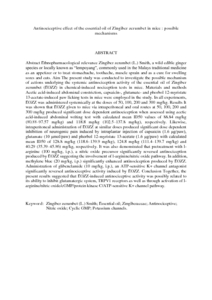Citation
Khalid, Mohamed Hanief and Akhtar, Muhammad Nadeem and Tengku Mohamad, Tengku Azam Shah and Perimal, Enoch Kumar and Omar Farouk, Ahmad Akira and Israf Ali, Daud Ahmad and Lajis, Md. Nordin and Sulaiman, Mohd Roslan
(2011)
Antinociceptive effect of the essential oil of Zingiber zerumbet in mice : possible mechanisms.
Journal of Ethnopharmacology, 137 (1).
pp. 345-351.
ISSN 0378-8741; ESSN: 1872-7573
Abstract
Abstract
Ethnopharmacological relevance
Zingiber zerumbet (L.) Smith, a wild edible ginger species or locally known as “lempoyang”, commonly used in the Malays traditional medicine as an appetizer or to treat stomachache, toothache, muscle sprain and as a cure for swelling sores and cuts.
Aim
The present study was conducted to investigate the possible mechanism of actions underlying the systemic antinociception activity of the essential oil of Zingiber zerumbet (EOZZ) in chemical-induced nociception tests in mice.
Materials and methods
Acetic acid-induced abdominal constriction, capsaicin-, glutamate- and phorbol 12-myristate 13-acetate-induced paw licking tests in mice were employed in the study. In all experiments, EOZZ was administered systemically at the doses of 50, 100, 200 and 300 mg/kg.
Results
It was shown that EOZZ given to mice via intraperitoneal and oral routes at 50, 100, 200 and 300 mg/kg produced significant dose dependent antinociception when assessed using acetic acid-induced abdominal writing test with calculated mean ID50 values of 88.84 mg/kg (80.88–97.57 mg/kg) and 118.8 mg/kg (102.5–137.8 mg/kg), respectively. Likewise, intraperitoneal administration of EOZZ at similar doses produced significant dose dependent inhibition of neurogenic pain induced by intraplantar injection of capsaicin (1.6 μg/paw), glutamate (10 μmol/paw) and phorbol 12-myristate 13-acetate (1.6 μg/paw) with calculated mean ID50 of 128.8 mg/kg (118.6–139.9 mg/kg), 124.8 mg/kg (111.4–139.7 mg/kg) and 40.29 (35.39–45.86) mg/kg, respectively. It was also demonstrated that pretreatment with l-arginine (100 mg/kg, i.p.), a nitric oxide precursor significantly reversed antinociception produced by EOZZ suggesting the involvement of l-arginine/nitric oxide pathway. In addition, methylene blue (20 mg/kg, i.p.) significantly enhanced antinociception produced by EOZZ. Administration of glibenclamide (10 mg/kg, i.p.), an ATP-sensitive K+ channel antagonist significantly reversed antinociceptive activity induced by EOZZ.
Conclusion
Together, the present results suggested that EOZZ-induced antinociceptive activity was possibly related to its ability to inhibit glutamatergic system, TRPV1 receptors as well as through activation of l-arginine/nitric oxide/cGMP/protein kinase C/ATP-sensitive K+ channel pathway.
Download File
![[img]](http://psasir.upm.edu.my/24556/1.hassmallThumbnailVersion/Antinociceptive%20effect%20of%20the%20essential%20oil%20of%20Zingiber%20zerumbet%20in%20mice.pdf)  Preview |
|
PDF (Abstract)
Antinociceptive effect of the essential oil of Zingiber zerumbet in mice.pdf
Download (189kB)
| Preview
|
|
Additional Metadata
Actions (login required)
 |
View Item |

